Excerpts from Jim Conrad's
Naturalist Newsletter
entry from field notes dated July 1, 2022, taken in an oak forest on the slopes of Cerro de la Cruz, elevation ~2750m (~9000 ft), rising on the south side of the community of El Pinar, Amealco de Bonfil, Querétaro, MÉXICO, (~N20.17°, ~W100.17°)
SWEETSCENTED MARIGOLD
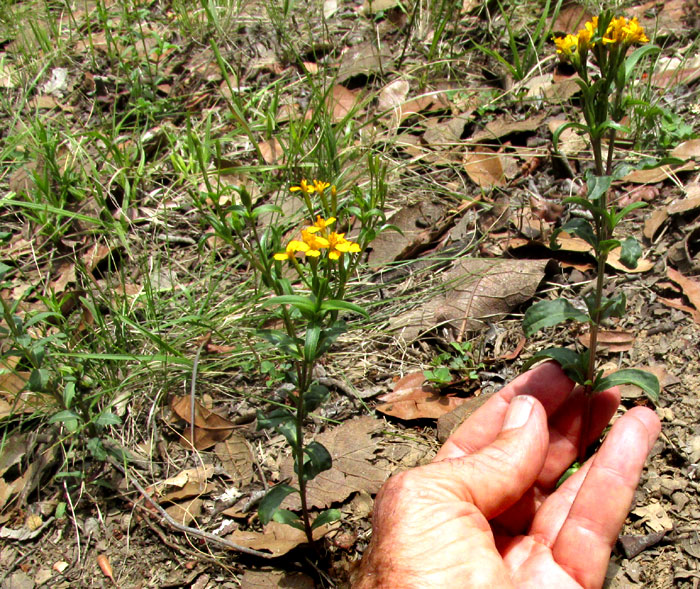
At the sunny edge of the oak forest mantling Cerro de la Cruz, where grass just begins to emerge from the ground's covering of oak leaves, the above wildflower showed up. With very small clusters of florets united into heads looking like regular flowers, with ray florets along the cluster's perimeter serving as petals, it was clearly a member of the vast Composite or Aster Family, the Asteraceae. The flowering stems in the picture arise from an older stem on the ground, sprouting from among a clump of leaves at the far left. This formation indicates that our plant is a perennial.
Usually it's hard to determine which of the 32,600 or so known species of the Aster Family one has, but as soon as I took hold of the plant to steady it in the wind, so it wouldn't blur in the above picture, I got a good hint that might help identify it: The herbage, when disturbed, issued the most spicy-sweet fragrance imaginable, maybe like a mixture of freshly ground cinnamon and anise.
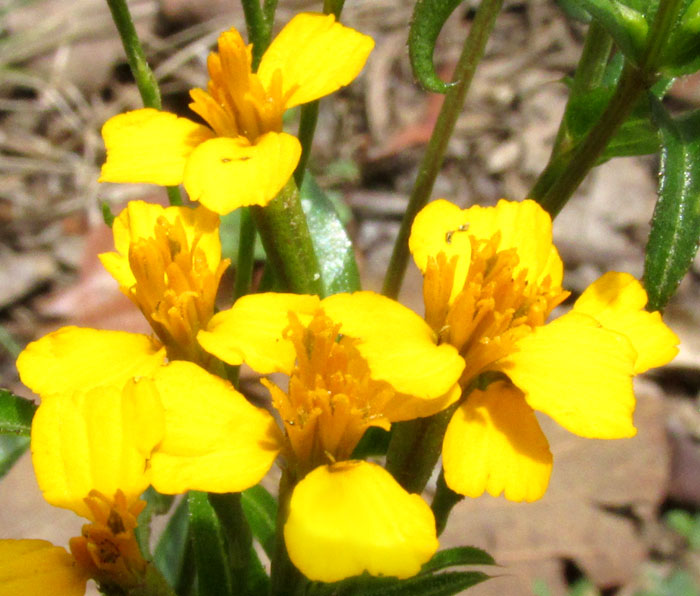
Up close, there were more hints. Each flower head, or capitulum, consisted of mostly five to eight cylindrical disc florets in each capitulum center, but only three petal-like ray florets.
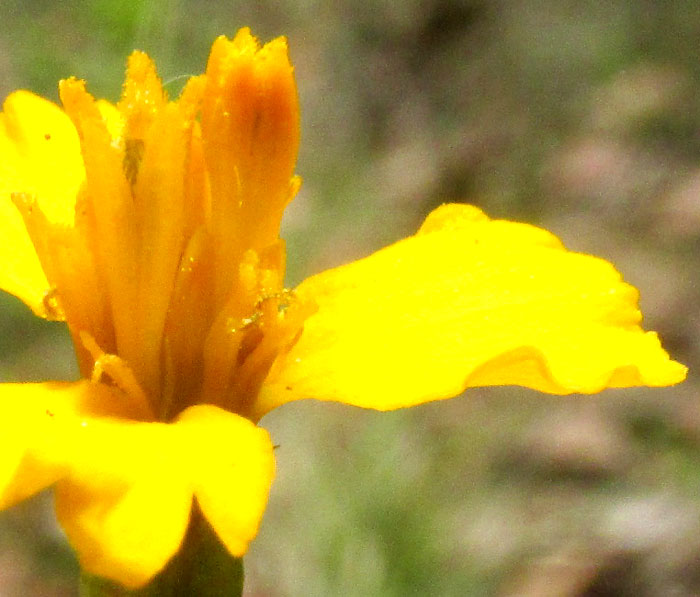
The disc florets, a little darker and orangish compared to the ray florets' bright yellow, rose well above the ray florets. Above, you can see slender, grainy-surfaced style arms curling from above the hidden ovaries/future fruits. The style arms bear stigmatic lines where pollen grains of the right kind are welcome to germinate.
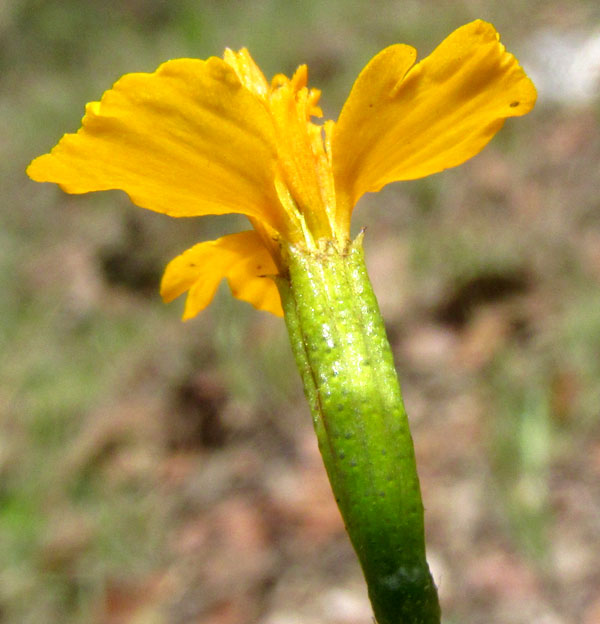
Above, the cylindrical, green structure holding the florets together as if it were a vase is the involucre. The involucre consists of about eight long bracts with their sides connected to one another. Typically, bracts are more or less scale like, often somewhat triangular in shape, and frequently they overlap, so these are unusual bracts. Also unusual are the pimply oil glands strewn across the bracts' surfaces. The glands also occur on all the plant's herbage, the aromatic oils in them providing the source of the plant's sweet fragrance.
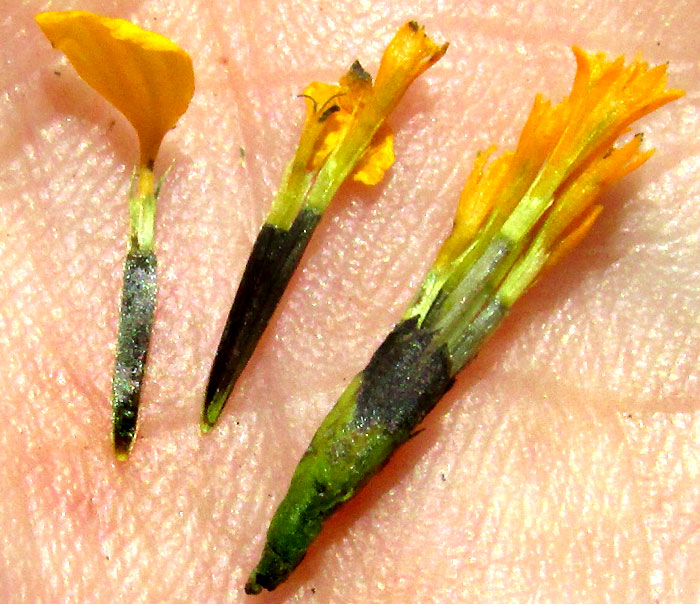
Above, on the right, a whole capitulum without its ray florets is shown. The involucre is turning black as it ages. Two or three disc floret's have been pulled from the involucre so that their ovaries -- the future one-seeded, cypsela-type fruit -- can be seen. Unlike in many Asteraceae capitula, here no papery palea separate individual ovaries from one another. Atop each ovary, which darkens with age, at the base of the corolla, there's a crown-like item composed of scales and two needle-like awns. This is the pappus, which can manifest in many forms. This combination of a scale crown with two awns is very diagnostic. On the disc and ray florets in the middle of the above picture, where now the cypselae are more mature and black, the awns are easier to see. On the left is a ray floret with its cypsela.
All the above features, especially the strong fragrance, the form of the involucre, the pappus with its crown of low scales and two needle-like awns, and even the color of the florets, will tell many gardeners that what we have here is some kind of marigold, one that's much simpler and showy than the cultivars usually planted.
Marigolds are members of the genus Tagetes, of which more than 40 species are recognized, all native only to the tropical and warm-temperate Americas, with their center of diversity here in Mexico. In North America, four species may be found in the wild. In Mexico, our dry, upland region of central Mexico known as the Bajío is home to eleven species. In our area, if you have a wild marigold whose leaves are not divided into lobes or segments, and which is perennial (like ours), you have TAGETES LUCIDA.
Tagetes lucida is native from northern Mexico south into El Salvador and Honduras, occurring mostly in disturbed and cut-over parts of oak, pine and tropical deciduous forest at elevations of 800-2700m (2600-8850ft). It goes by numerous English names, such as Sweetscented Marigold, Mexican Mint Marigold, Spanish Tarragon, Winter Tarragon, Mexican Tarragon, Texas Tarragon, Sweet Mace and Mexican Marigold. Sweetscented Marigold seems to be the most used on the Internet.
Our Sweetscented Marigold is only rarely planted in northern gardens, though sometimes it is down here. Still, Tagetes lucida has a rich ethnobotanical history.
Medicinally, a long list of traditional uses has been documented, from controlling diarrhea, rheumatism and chills, to aborting pregnancies and getting rid of intestinal worms, plus its leaves have been burned to shoo away mosquitoes. It's especially known for helping problems with the digestive system.
G. Pérez-Ortega and others in a 2016 study entitled "Tagetes lucida Cav.: Ethnobotany, phytochemistry and pharmacology of its tranquilizing properties" concluded that their results "... support the anxiolytic [anxiety reducing] and sedative-like properties of T. lucida in traditional medicine by involving serotonergic and GABAergic neurotransmission and coumarinic constituents."
As a food, its leaves are dried and ground into a powder for flavoring soups and sauces. In D Bown's 1995 book Encyclopaedia of Herbs and their Uses it's said that our plant was used to flavor the cocoa-based chocolatl drink the ancient Aztecs were fond of.
In traditional permaculture systems, Tagetes lucida has been used in crop rotation to rid the soil of nematodes and other pathogenic organisms.
Finally, it's been used in traditional religious ceremonies and has some fame as hallucinogenic. At this writing, a certain website sells it for about $10/25g, pointing out that our plant contains a substance very similar to salvinorin, which is an extremely powerful compound "for altering consciousness and one of the most potent, naturally occurring hallucinogens."
from the August 24, 2007 Newsletter issued from Sierra Gorda Biosphere Reserve, QUERÉTARO, MÉXICO
BOUQUETS OF SANTA MARÍA
As soon as we reached a pasturing place near our hike destination Marcelino's son, Marcelo, began gathering the bouquet he's holding below:
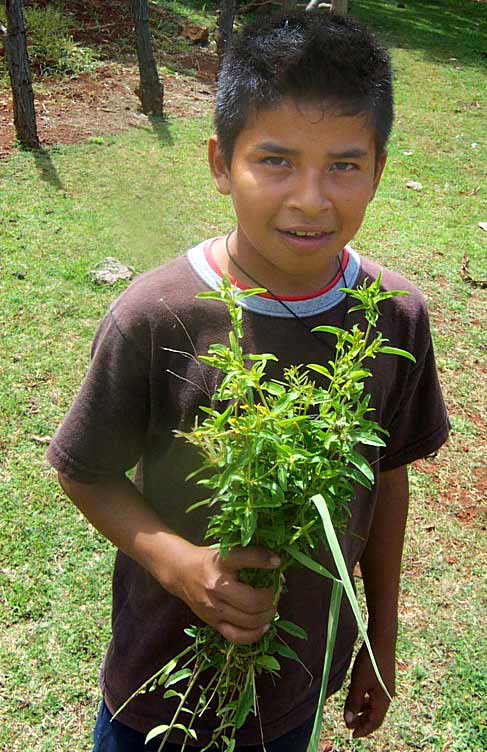
I didn't need to ask Marcelo why he was collecting such a colorless bouquet, for I could smell the reason twenty feet away: A wonderfully sweet fragrance like that of anise with a touch of tarragon suffused the warm, moist mountain-air. These plants were destined for making tea.
I could have almost guessed as well what the plant's name would be, for it's Santa María. Around here anything smelling so sweet and good automatically gets named after the Virgin! The mushroom-picking lady I told you about last week saw a perfectly amorphous lump of limestone protruding from the ground and exclaimed "Oh, it's just like The Cross!" Anyway, that name Santa María didn't help much to let me know what the plant was botanically. Mexico is overpopulated with good-smelling herbs called Santa María.
Most stems Marcelo had collected were too young to bear flowers, but a few did, so I got them and surprised myself when I saw that they exhibited the unmistakable anatomy of marigold flowers, as outlined on my marigold flower-anatomy page at www.backyardnature.net/fl_marig.htm.
Most people don't think crushed marigold leaves smell very good, and you know how gardeners deploy them for their insecticidal property. Therefore, I'd expected this fragrant, tea-making herb to be just about anything other than a stinky, pesticidal marigold.
When I say that it was indeed a marigold species I'm referring to the fact that it was a member of the genus Tagetes. It was TAGETES LUCIDA, in much of Mexico known as Pericón, and often marketed commercially in English as Mexican Tarragon, Mexican Mint Marigold, and by other names as well.
The main use my Plantas Medicinales de México gives for the plant is that of making the water smell good that children are bathed in. I can just imagine being a kid in a shadowy little hut in the mountains while roosters crow and Mamá sings a little song, being washed with springwater smelling this good. Maybe experiences like that account for why Mexican country people are often such agreeable folks.
At least one source claims that particularly strong infusions of Tagetes lucida "produce similar closed-eye-images as Peyote or a very mild state of euphoria and has been used since pre-Hispanic times."
By the time we began our return trip Marcelo had picked two large bouquets of Santa María. He needed to position the woven-plastic bag he used as a saddle on his mule's back so he had to lay one of the bouquets on the ground. Well, all that day Marcelo's mule had given the impression that he was the most dull-witted, lethargic creature on Earth. However, the very instant Marcelo's back was turned that mule, quick as lightning, snaked his neck around and in half a second most of the bouquet disappeared into his mouth. When Marcelo saw what had happened he rushed back beating his sombrero against the mule's ribs.
"¡Qué bárbaro!" he exclaimed.